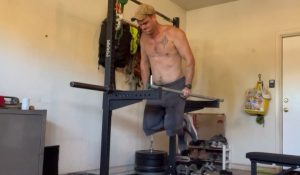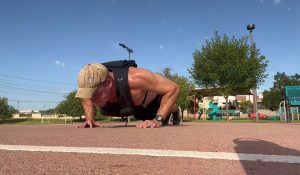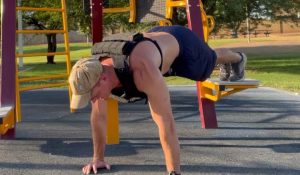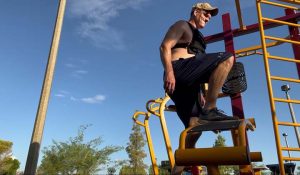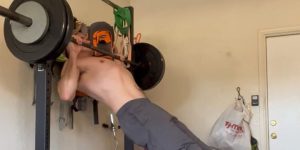Fancy workout equipment and routines are great – when we’ve got the time. But what about when we don’t? Is it possible to pare down a workout to its bare bones, to “hack away the unessential” (in the words of Bruce Lee).
Dips and pull-ups only, together in an antagonistic superset, are one of the quickest ways to approach muscular failure, get a pump, and get on with your life. If you’re following evidence-based guidelines for muscle growth (doing 10-20 sets per exercise near failure, split between 2-3 weekly workouts), then we’ll see results.
There’s no way for it not to work unless we just don’t do it.
Why Only Do Pull-Ups and Dips?
Let’s do a quick mental exercise. You’re in the gym, doing an upper body day, and you’ve got to finish your workout in record time. What do you do?
If I told you that you were to only do bench press, and superset it with some type of seated cable row, do you think you could get a pump? How long would it take, including warm-up sets, to complete five rounds to near failure? 20 minutes? 25?
Maybe you’d finish with some myo reps on a barbell or dumbbell curl, or perform a burn-out agonist superset with pushups, and then be done. Would it work?
Sure, it would! These are time-tested, bomb-proof ways to add slabs of muscle to anyone’s frame.
So, why then, wouldn’t we be able to replicate the exact same methodology with a simple regimen of these exercises’ calisthenic counterparts: the bodyweight dip and pull-up?
Here are a few reasons to try spending at least a little bit of time using only pull-ups and dips in your upper body routines:
1. They’re Tough, but Effective
It’s been said many times before, but I’ll say it again. The body doesn’t know the difference between mechanical tension from weights or from bodyweight exercises.
Let’s face it – pull-ups and dips are not for the faint of heart. They require at least a modicum of strength and muscular endurance to perform them correctly, and that’s what makes them a good choice for someone wanting to do something closer to “strength training” utilizing minimal equipment or time.
Pull-ups target the back, biceps, and rear delts, while dips benefit the chest, triceps, and shoulders.
By only doing these two exercises, you’ll be working all the major upper body muscle groups, resulting in impressive gains in strength and size.
2. No Need for Complex Equipment
Pull-ups can be done anywhere that you’ve got something to hang from:
- A doorway pull-up bar
- A squat rack
- A tree
- Some rafters with gymnastic rings thrown over them
Dips can be done in more locations than you think:
- Between two chairs in your kitchen
- On the intersection between two countertops
- On a dedicated dip stand (if you’ve got one)
Therefore, another great benefit of only doing pull-ups and dips is that they don’t require complex equipment or a gym membership.
All you need is a sturdy pull-up bar and parallel bars for dips, which are relatively inexpensive and can be set up at home. This makes them a great option for those who prefer to work out at home or have limited access to gym equipment.
3. They are time-saving
If you’re prone to exercising in fits and starts (one month on, two months off, etc), then this may be the method for you. These workouts shouldn’t take longer than 15 minutes.
By focusing solely on pull-ups and dips for a while, you’ll save time in your workouts. You won’t need to spend hours doing multiple exercises to target the same muscle groups, since these two exercises are so efficient and cover so many muscle groups.
Additionally, using basic pyramid-style rep schemes can allow built-in warm-ups and cool-downs into the workout, meaning a lot can be accomplished with very little planning or time investment.
But what about progressive overload?

A common objection to this style of training is that the exercises are more difficult to progressively overload than traditional barbell exercises.
Perhaps we should ask some of the muscle-building greats, like Vince Gironda, Doug Hepburn, or Arnold Schwarzenegger what they think on this topic? All three of them were renowned for their fondness of weighted dips and pull-ups in their routines.
Sure, overloading these exercises isn’t a simple matter of slapping an extra 5 on each side of the bar, but …
The obvious thing here should be that there are multiple ways to externally load pull-ups and dips:
- Dip belts
- Weight vests
- Chains
- Dumbells or plates held between the legs
However, the slightly less obvious (to the iron devotees) element is that external loading is not the only way to progressively overload an exercise. Consider that you could:
- Add repetitions
- Add pauses at the top of each rep
- Add pauses at the bottom of each rep
- Add pauses in the middle of each rep
- Decrease our rest periods
- Alter the cadence of the exercise (explosive concentric, 3-4 second slow eccentric)
The fact is that there are many ways to progressively overload any exercise, and that includes pull-ups and dips.
A simple way to incorporate pull-ups and dips into your workout routine

Let’s talk about how to incorporate these exercises into your workout routine. Here’s a sample workout plan to get you started. This guide could be used as the basis of a bodyweight upper/lower split routine, or combined with a leg exercise to form a full-body session.
Start each session with a short warm-up to get the blood flowing, and then:
Workout A (Monday):
- Pull-Ups: Do three sets of as many pull-ups as you can, resting for 30 seconds between sets.
- Dips: Do three sets of as many dips as you can, resting for 30 seconds between sets.
Workout B (Wednesday):
- Complete a set of dips, leaving two reps in reserve, followed immediately by a set of pull-ups, leaving two reps in reserve.
- Repeat three more times, for a total of four rounds.
- On the last set, go “all out” (zero reps in reserve).
Workout C (Friday):
- Dips: One set, leaving two reps in reserve. Rest for 1 minute.
- Pull Ups: One set, leaving two reps in reserve. Rest for 1 minute.
- Dips: Myo reps or rest-pause – ONE set. Rest for 1 minute.
- Pull Ups: Myo reps or rest-pause – ONE set.
Repeat the three workouts each week for 3-4 weeks, then take a week off to allow the body to recover. Rinse and repeat, attempting to add reps each time the same workout comes up again.
It’s important to note that this workout plan is just a starting point. As you get stronger and more comfortable with pull-ups and dips, you can increase the number of sets and reps, or try more challenging variations of the exercises, such as weighted pull-ups or ring dips.
Incorporating Pull-Ups and Dips into a Full-Body Workout
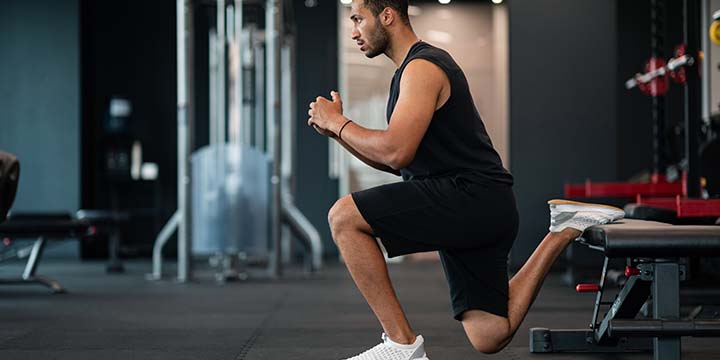
If you’re not the “upper / lower” type of guy and would prefer full-body routines instead, worry not. This can be accomplished simply by adding a leg exercise into each session above.
Below is a sample “full body” version of a workout including pull-ups and dips:
- Warm-up: Get the blood flowing and warm up the joints, but don’t take more than a few minutes – remember, time is of the essence here.
- Pull-Ups: Do four sets of as many pull-ups as you can, resting for 30 seconds between sets.
- Dips: Do four sets of as many dips as you can, resting for 30 seconds between sets.
- Bulgarian split squats (on a chair or bench): Three sets of as many reps as possible in 30 seconds per leg (start with your weaker leg first, then match the number of reps with the other leg).
Easy peasy. For some variety, include cossack squats or other single-leg exercises in place of the Bulgarian split squats.
If you’d like to learn more about how to incorporate these basic exercises into a full weekly plan, see my article on heavy, light, medium programming for calisthenics.
Tips for Success
Only sets “near failure” count. Since we’re not adding weight to the bar, we’re going to rely on doing sets close to failure. Remember, these workouts are short. It’s not a good time to cut corners with effort.
Use a full range of motion. These exercises can be challenging, and it’s easy to cut a rep’s range of motion in the name of adding reps. Resist the urge to do so. It’s well established at this point that a longer range of motion leads to better hypertrophic outcomes.
Vary your grips. While this is not strictly essential, it is old wisdom for a reason – it helps us achieve our goals by utilizing the muscles from slightly varied angles in each set. Pull-ups can be done with a neutral grip, shoulder-width grip, wide grip, or supinated grip (chin-ups). Dips can be done wide, narrow, chest forward (chest dips), or chest up (triceps dips).
Be consistent. Muscle building is a slow process. Consistency matters more than anything else. Your workouts don’t need to be fancy, but you need to actually do them. I often tell people to think in years rather than months. We’re talking about 10-minute workouts here – keep this up for 6-12 months, and you’ll be a different person.
Conclusion
In conclusion, only doing pull-ups and dips for upper body development may fly in the face of conventional wisdom, but let me ask you – how have your results been so far?
If you’re prone to quitting exercise, not giving all-out effort, or “program hopping”, it may be worth it for you to try the minimalist approach for a while. Stick with it, and push hard.
You’ll be pleased that you did.













